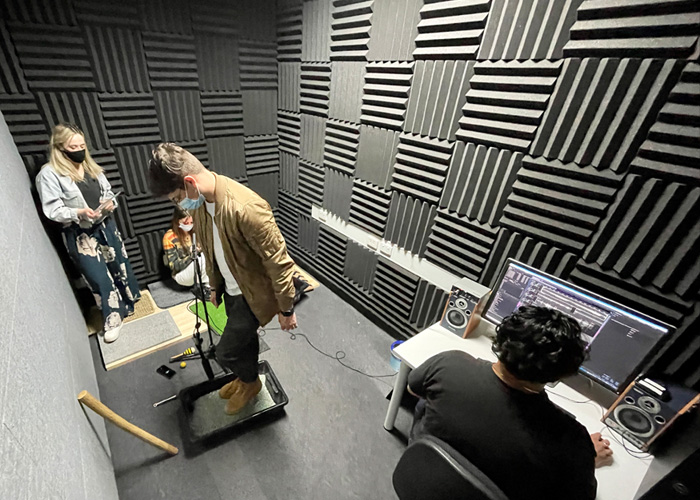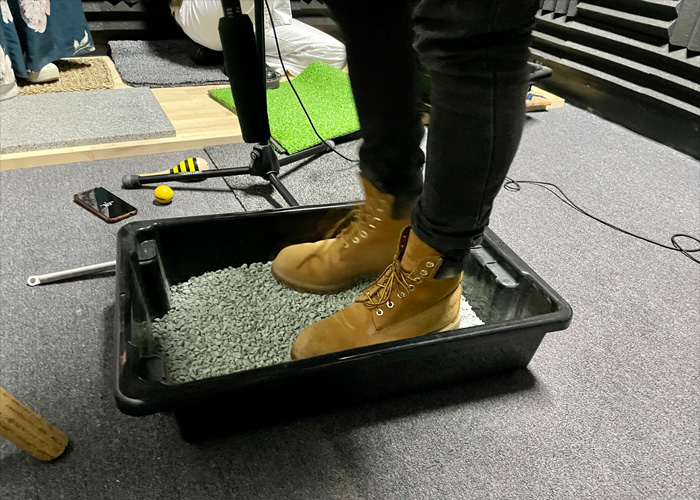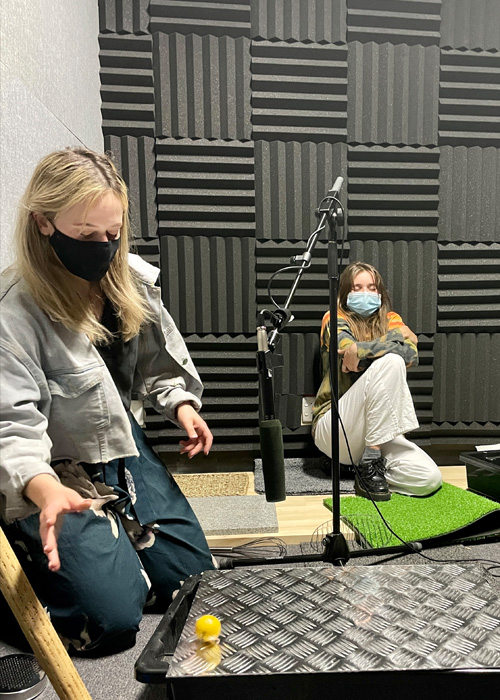
The Foley Room is Flinders’ latest addition to several resources such as The Void or the film equipment store that students have access to when creating films. When it comes to filmmaking, sound is half the story. People will watch a film with bad images but not with bad sound.
Screen Lecturer Dr Tom Young tells us, “What is important to note, is that the sound of a film is multi-layered – it’s not just the sound of what is happening in the foreground but also includes foley, atmospheric (background) sounds, dialogue and music. There are thousands of little sounds that make up a full body mix. The layering and depth of these sounds are crucial for the end result.
“At Flinders we want to focus more on sounds this year and step up the quality of our students’ films. For this we’ve opened up a brand-new Foley Room and are constantly adding to our library of materials.”
So, what’s in the Foley Room?
The Foley Room is a soundproof room with lots of different items to experiment with. Students from the Bachelor of Creative Arts (Screen) can choose from “a range of different flooring surfaces such as wood, grass, carpet, tiles, metal grating, bark chips, metals, sand, etc”. Lecturer Helen Carter continues, “We also have kitchen utensils, wooden objects, toys and musical instruments. Anything that can make a sound is useful.”
New elements are being added to the Foley Room every week. The sounds resulting from these props can be directly recorded into the computer via a XLR connection and by using Adobe Edition. Thanks to the dead quiet nature of the Foley Room, the sounds are isolated, clean and crisp.
Tom explains, “A 90-minute feature film involves tens of thousands of sounds. You have to consider both what is happening inside and outside of the scene. Say if the scene is set inside a house, a filmmaker also needs to take into account what is happening outside. Can you hear birds or traffic?”
“The experience of recording foley sounds is very tactile and creative. It’s also a fun way to add value to a film and to learn valuable new skills”, Helen adds.

How the Foley Room is used in class
Helen tells us how the Foley Room is integrated into teaching, “We teach students how to use the sound recording equipment in there as well as the basics for creating sounds with objects. Then we try to be creative about what objects might make the sound we’re after. Students experiment with the resources to make suitable sounds for their films. Often several sounds are layered together to make it sound just right”.
Screen student Charles Li says, “It was surprising for me to find out just how amazing a bag of cornflour sounds. By simply adjusting the tilting angle when sliding it around inside a box, you can create almost every variant of snow/skiing sounds, fast, slow, heavy, light, etc. You’d be surprised how different those variants sound in editing”.
Tom gives the example of the foley assignment ‘Welcome to my party’, “This project covers all sorts of kids’ sounds to work on at home. Now students can record everything in this specialist space.” Helen elaborates, “Students are currently working out the best way to make the party sounds. Most of the shots feature everyday props such as balloons, party whistles and poppers, along with the making of fruit punch and playing music”.

Surprising experiments
Screen student Jingqian Liang loved working in the Foley Room, “It’s really a very meaningful experience, in such a mysterious and narrow room we can create so many sounds, to create our own world which makes our films more vivid. My favourite thing about the Foley Room is a group of people who love filming and recording being able to gather in this tiny and quiet room, to collect and create our own voices and our own memories.”
“We used the lawn to make different walking sounds such as walking on the beach and walking on rocks. Lightly stepping on the lawn and stepping on the lawn while creating a little friction can give you the sound of walking on different textures which is amazing.”
Charles adds, “There were definitely sounds from different scenes that shared some usage of common materials here and there, mostly due to them containing the same elements and characteristics.
“For example, both waterfall and rain contain the element of individual drops impacting a surface. While the latter scenario relies on it being heavier than the prior, they can both be made using the same material when recording. It’s just the difference in how you layer them in post-production. Do we put the sound in the foreground or background? Should it be the backbone or just an element that we are adding for the fullness?”
Charles remembers the recreation of a campfire as his personal highlight, “It was perhaps the most successful experiment of this project because I didn’t believe how easy it would be to make cellophane sound EXACTLY like the campfire. You pick up the cellophane and squeeze it, and there you have it! I might be biased on this because it’s also one of the few sounds you don’t need to sync with picture, which saves lots of time in post-production, and as an editor that is very appealing.”

How the Foley Room enhances the learning experience at Flinders
Jingqian raves, “Flinders University provides the student with the most useful experiences. They offer professional filming equipment and the Foley Room to improve our comprehensive skills. In the Foley Room, we don’t just learn the ins and outs of sound making, you also get a deeper understanding of the film itself.”
Charles, too, feels he has majorly benefitted from the new facility, “Sound is one of the most important components of films. Creating foley sounds is as technical as it is performative, and it’s an essential element to learn in the film production process.”

